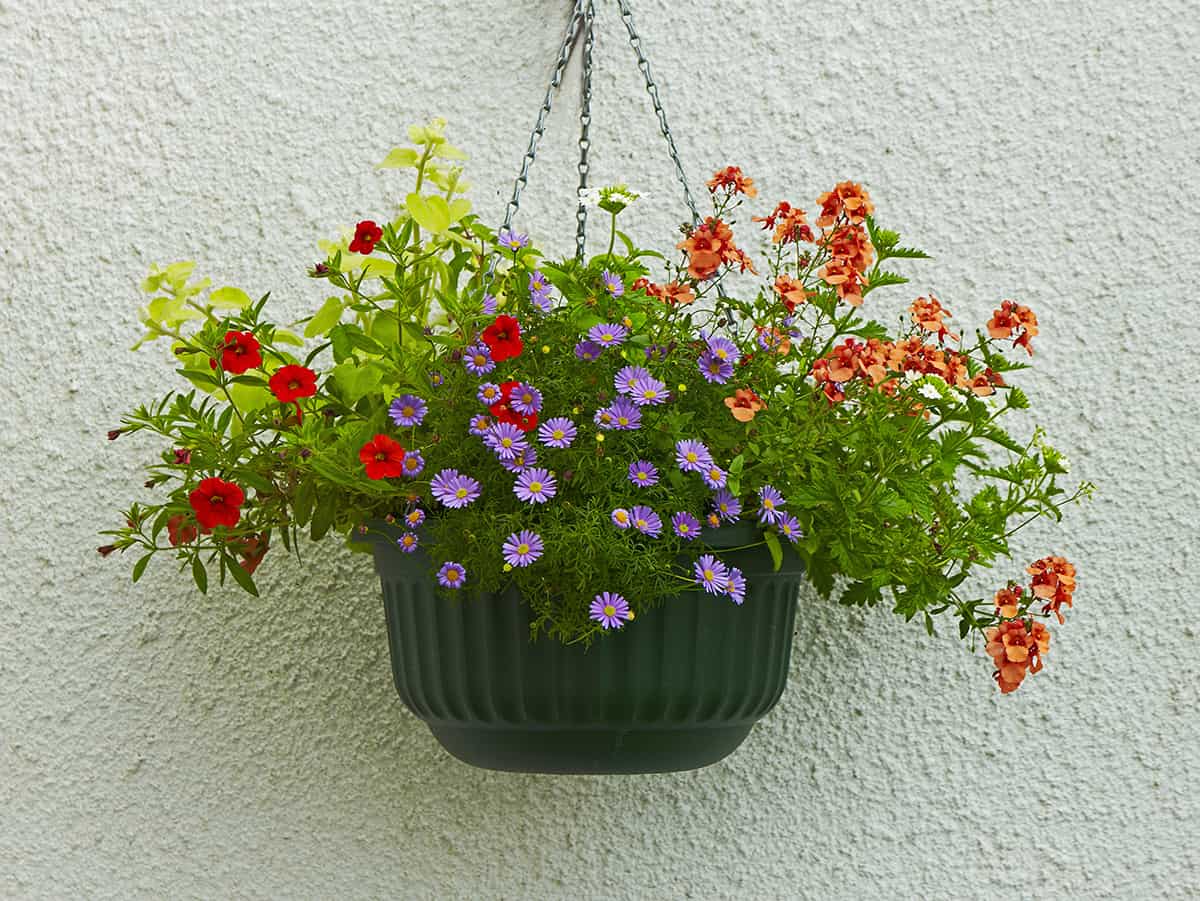If you’re looking to brighten up your small balcony or add a touch of greenery to your porch without sacrificing floor space, consider hanging baskets. Filling them with plants like trailing petunias, lush ferns, or vibrant begonias allows you to create an eye-catching display that floats above the ground, maximizing your living area while enjoying bursts of color and foliage.
Table of Contents
Petunias
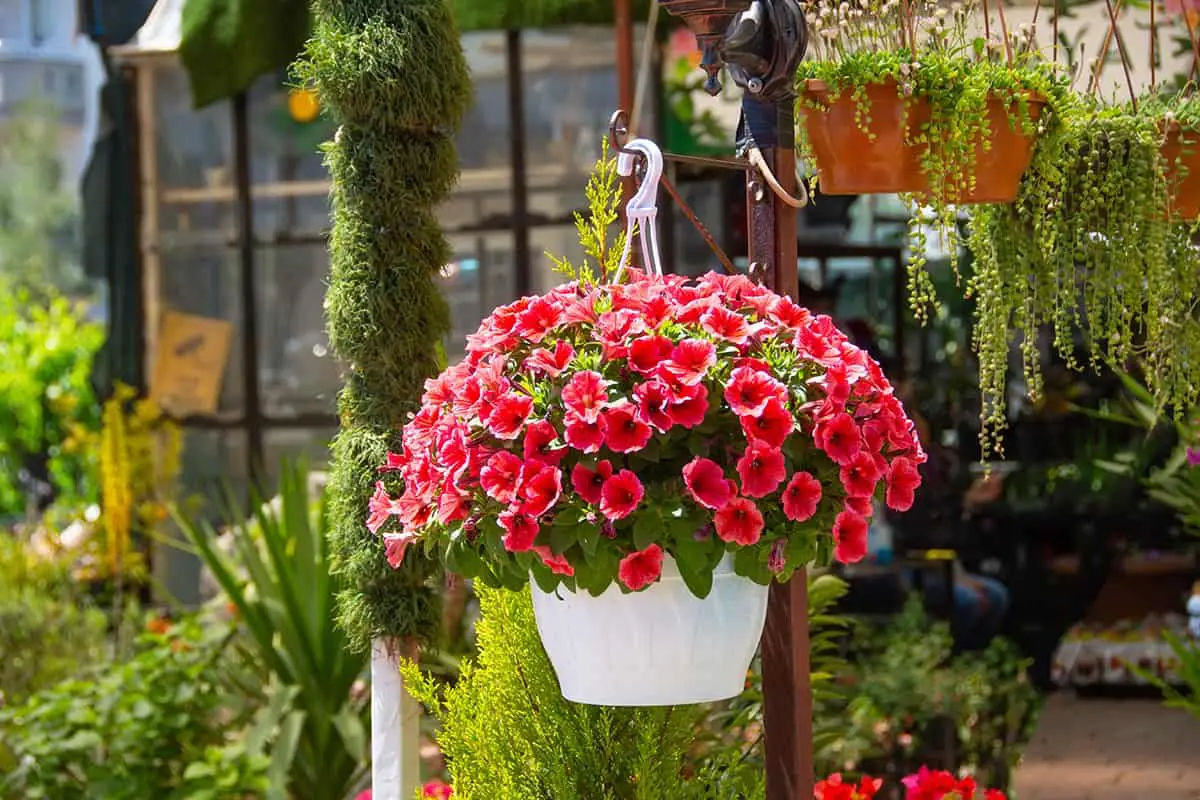
Petunias are a top choice for your hanging baskets. These vibrant flowers offer mounding, trailing growth, which makes them perfect for both filling and spilling over the edges of containers. They thrive in full sun and well-drained soil, keeping your display bright and lively throughout the growing season.
For vigorous growth, maintain moist soil and ensure they receive at least six hours of sunlight daily. Petunias come in a variety of colors, allowing you to create a truly personalized arrangement. Proper care includes regular watering and weekly fertilization to support their abundant flowering.
Selecting petunias for your hanging baskets involves choosing healthy, compact plants. This encourages a fuller and more attractive growth over time. In regions such as Florida, planting occurs optimally during October and November.
Night temperatures ranging from 55 to 65 degrees Fahrenheit are ideal. For an eye-catching display, pair petunias with Superbells for contrasting textures and added dimension.
Fuchsia

Fuchsias are ideal for your hanging baskets with their vivid blooms and elegant drooping stems. You can witness their striking colors from spring until the first frost hits. These flowers adapt to a range of lighting conditions, flourishing in anything from morning sun to partial shade.
Place fuchsias in well-drained soil to prevent root rot. They require consistent watering, allowing the soil to dry slightly between waterings. Feed them every few weeks with a balanced liquid fertilizer to promote strong growth and abundant flowering.
Choose varieties like ‘Swingtime’ Fuchsia or ‘Jubilee’ Fuchsia for large, showy flowers. Hardy fuchsias like Fuchsia magellanica can even survive mild winters. Indoors, overwinter your plants in cool areas like basements where they can rest until spring.
Fuchsias attract hummingbirds and are generally low-maintenance. Keep them thriving by deadheading spent flowers and pinching back stems to encourage bushy growth.
Geraniums (Pelargonium)
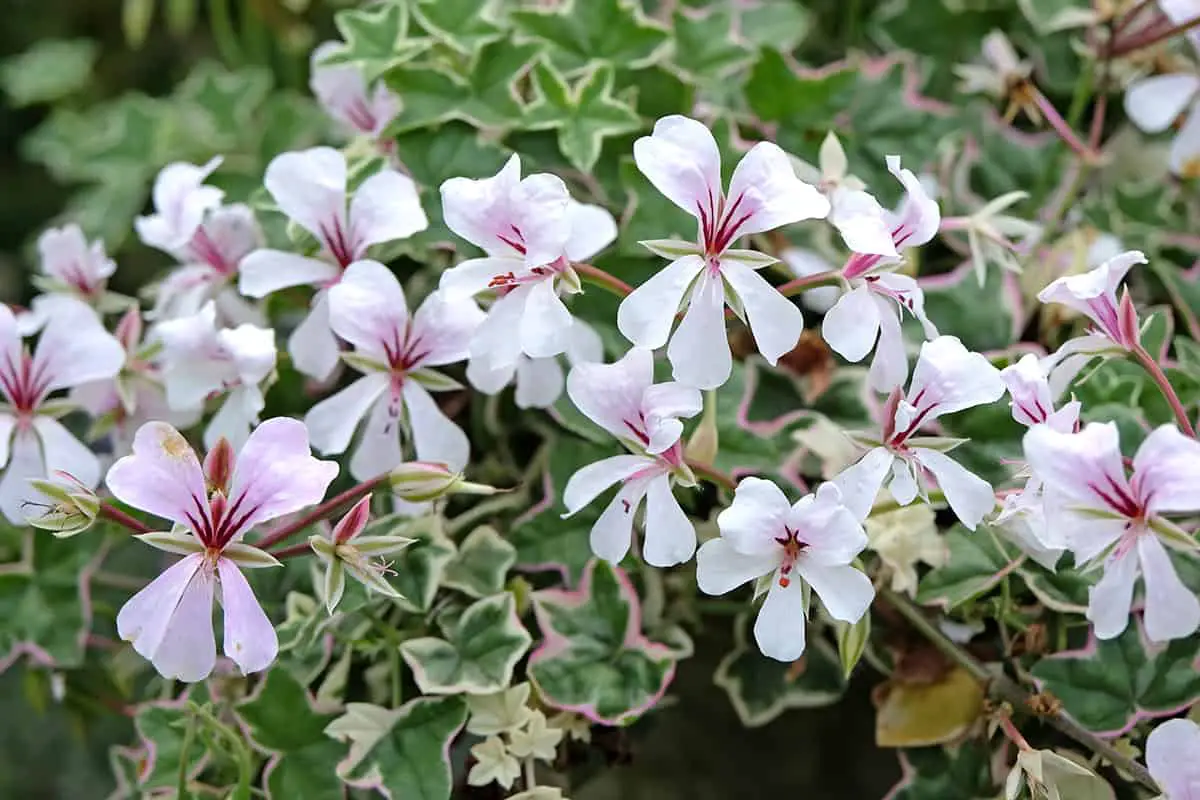
Geraniums make excellent choices for your hanging baskets due to their bright blooms and trailing foliage. You’ll find these plants offer a robust display of colors, from whites to pinks to reds. They’re not only visually appealing but also hardy and easy to care for.
These plants need sunlight to flower well. Ensure they get at least 6 hours of direct light daily. When you provide this much light, geraniums reward you with plentiful blossoms. They also require well-draining soil to prevent root rot.
There are different types of geraniums suitable for hanging baskets. The ivy geraniums are favored for their cascading growth and tolerance to some shade. For bolder flowers, consider the Martha Washington geranium. It’s known for large, ruffled flowers and prefers cooler conditions.
When watering geraniums, consistency is key. You should ensure the soil is moist but not waterlogged. During the growing season, apply a balanced fertilizer monthly to help your geranium thrive.
Begonias
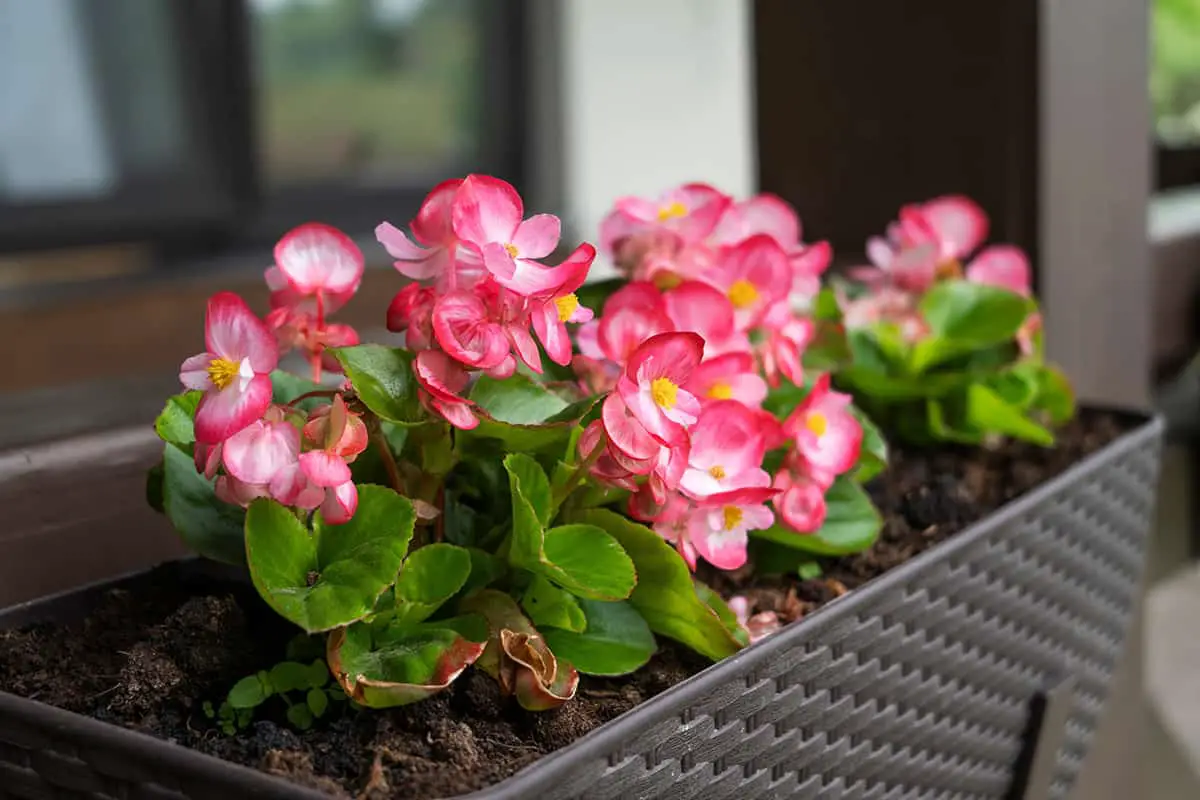
Begonias are ideal for your hanging baskets. With their rich foliage and vibrant blooms, they create a stunning visual display. You can enjoy a variety of colors, such as begonias, which come in shades of white, yellow, orange, red, and pink.
Select tuberous begonias for baskets. They have a cascading habit that drapes elegantly over the sides. Trailing stems can reach up to 18 inches, adding drama to your outdoor space.
Plant your begonias in a shady spot. They thrive in cool, moist conditions away from direct sunlight. For a flourishing display, maintain consistent watering and provide well-draining soil.
You should know begonias require winter care. In colder regions, bring them indoors before the first frost. Store tubers in a dry, dark place until spring. This ensures they’ll be ready for another season of beauty.
Lobelia
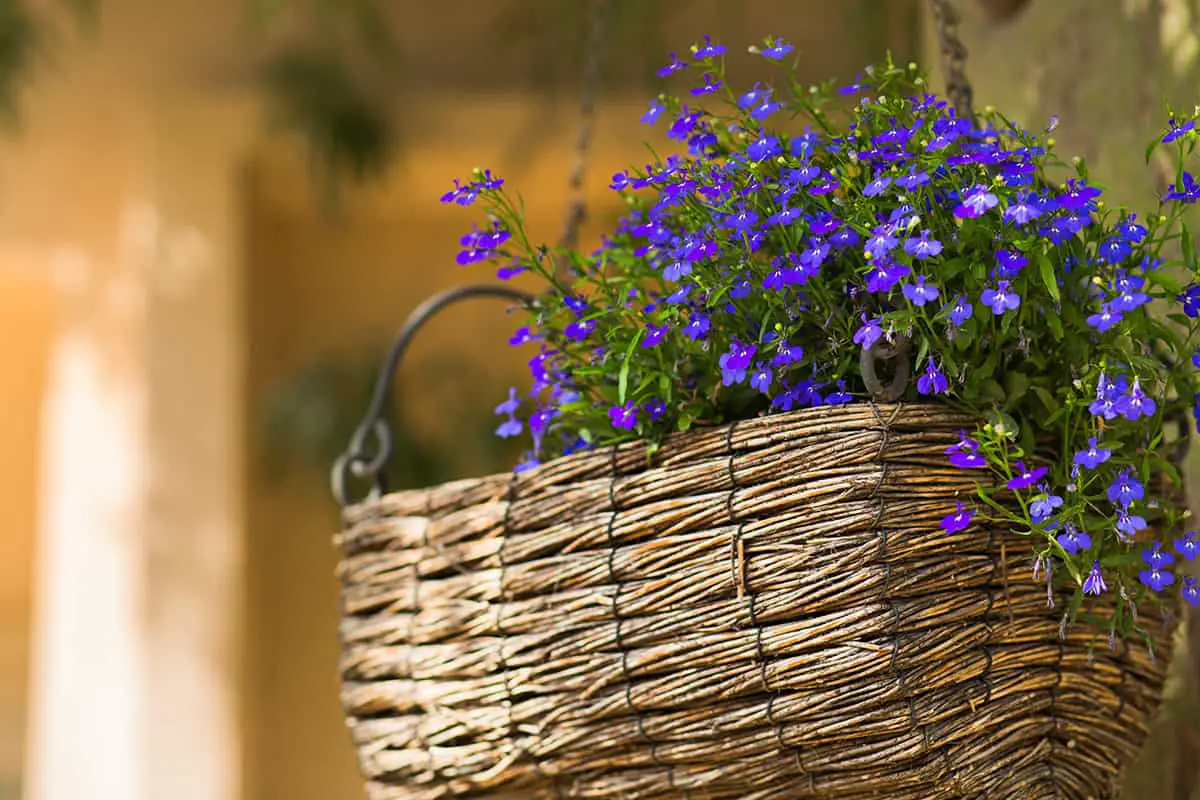
Lobelia is a top choice for your hanging baskets. Its vibrant flowers cascade gracefully, making it a visually appealing addition to any outdoor space. With varieties like ‘Sapphire’ that offer regal purple blossoms, Lobelia enriches your garden palette.
When you plant Lobelia, ensure it receives partial sunlight and stays protected from the afternoon heat, especially in warmer regions. This plant thrives in cool conditions but does not withstand frost well.
For sustained blooming, it’s a smart practice to cut back the Lobelia after a flowering period. This encourages new blossoms and maintains the plant’s lush appearance.
For an effective display, mix Lobelia with other plants that match its care needs. You can achieve striking visual contrast by pairing its trailing form with more upright flowers. Remember to choose a sizable hanging basket if you plan to combine multiple plants; this provides adequate space for each to flourish.
Sweet Alyssum (Lobularia Maritima)
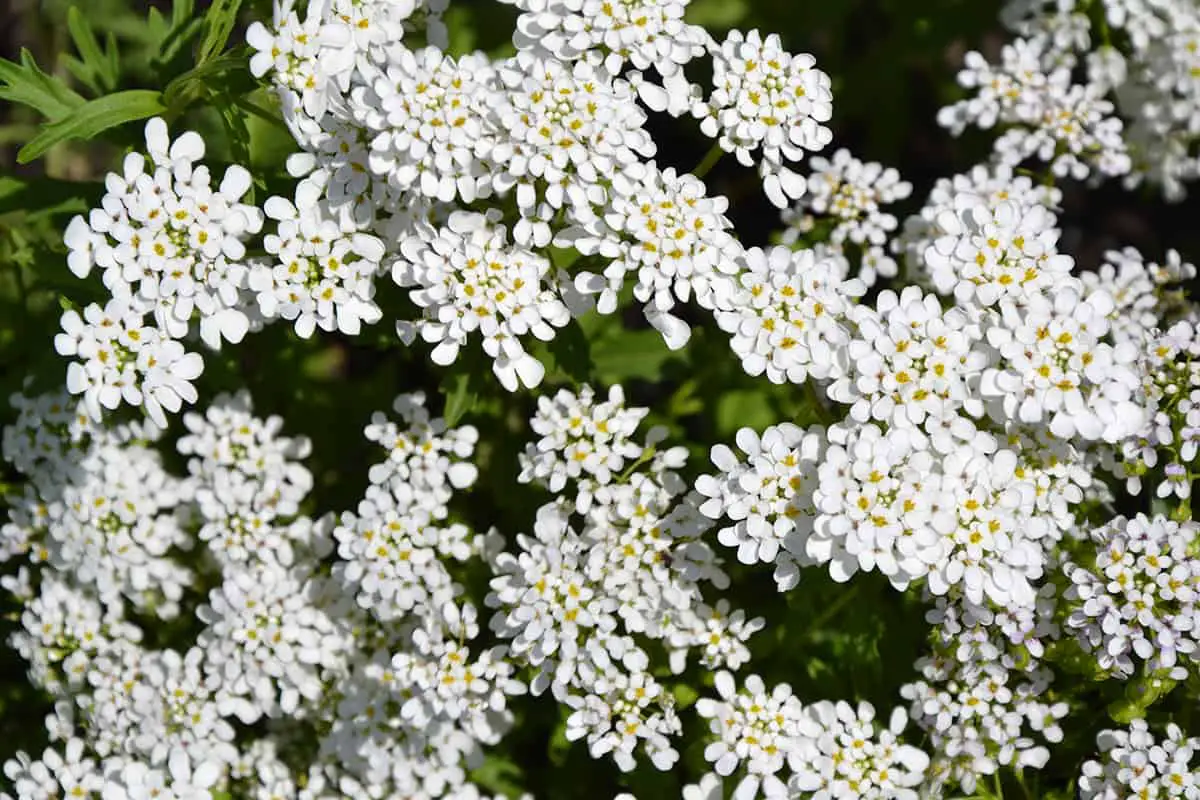
Sweet Alyssum is a splendid choice for your hanging baskets. Its small, honey-scented flowers blossom in shades of white, pink, rose, or purple. You will appreciate its low-growing, mat-forming habit, which creates a lush spill-over effect. With its origin in sunny, rocky areas of the Mediterranean, this plant adapts well to similar garden conditions.
Sweet Alyssum flowers from late spring until the first frost. You can expect blooms within 6 to 8 weeks after planting. By choosing Sweet Alyssum, you ensure continual color and fragrance in your space.
It thrives in well-draining soil. Water your plants consistently. However, Sweet Alyssum is drought-tolerant once established. For optimal growth, place your baskets where they will receive full sun to partial shade.
If growth slows in extreme heat, trim the plants back. Sweet Alyssum will rebound with fresh growth and blooms.
Million Bells (Calibrachoa)
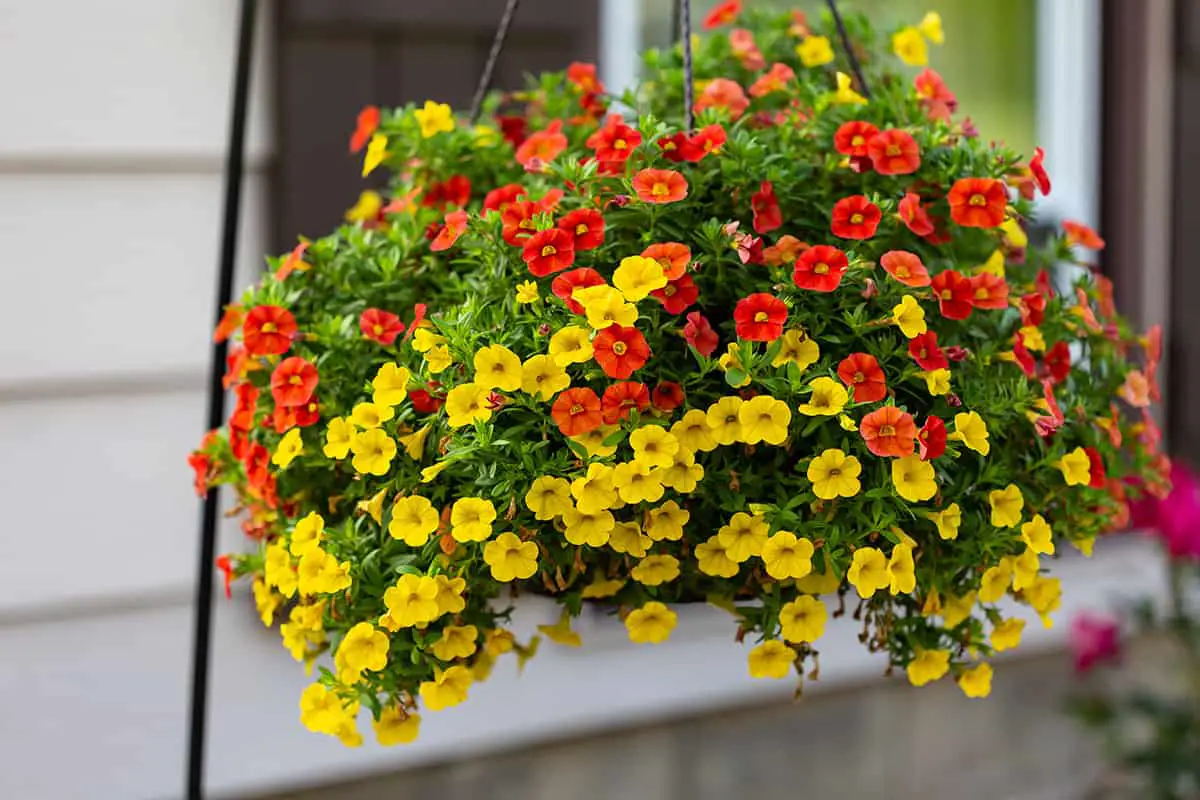
Million Bells, or Calibrachoa, are ideal for hanging baskets. These plants resemble petite petunias with their abundant, bell-shaped flowers. Native to South America, they bloom from spring until the first frost. You will find them in a wide range of colors, including pink, red, yellow, and purple.
Your hanging basket will thrive with Calibrachoa as they enjoy full sun to part shade. They typically grow 6-12 inches tall, making them perfect for a cascading floral display. For best results, ensure they have well-drained soil. Regular watering is essential, but take care not to overwater.
Another benefit of choosing Million Bells is low maintenance. They don’t require deadheading to continue blooming, so you will spend less time on upkeep. Fertilize them every other week to keep flowers vibrant and plants healthy.
Expect hummingbirds and butterflies to visit your hanging baskets often. These visitors love the nectar-rich flowers of Calibrachoa. By planting Million Bells, you create a lively and colorful garden space. Remember to protect them from frost to enjoy their beauty for as long as possible.
Impatiens
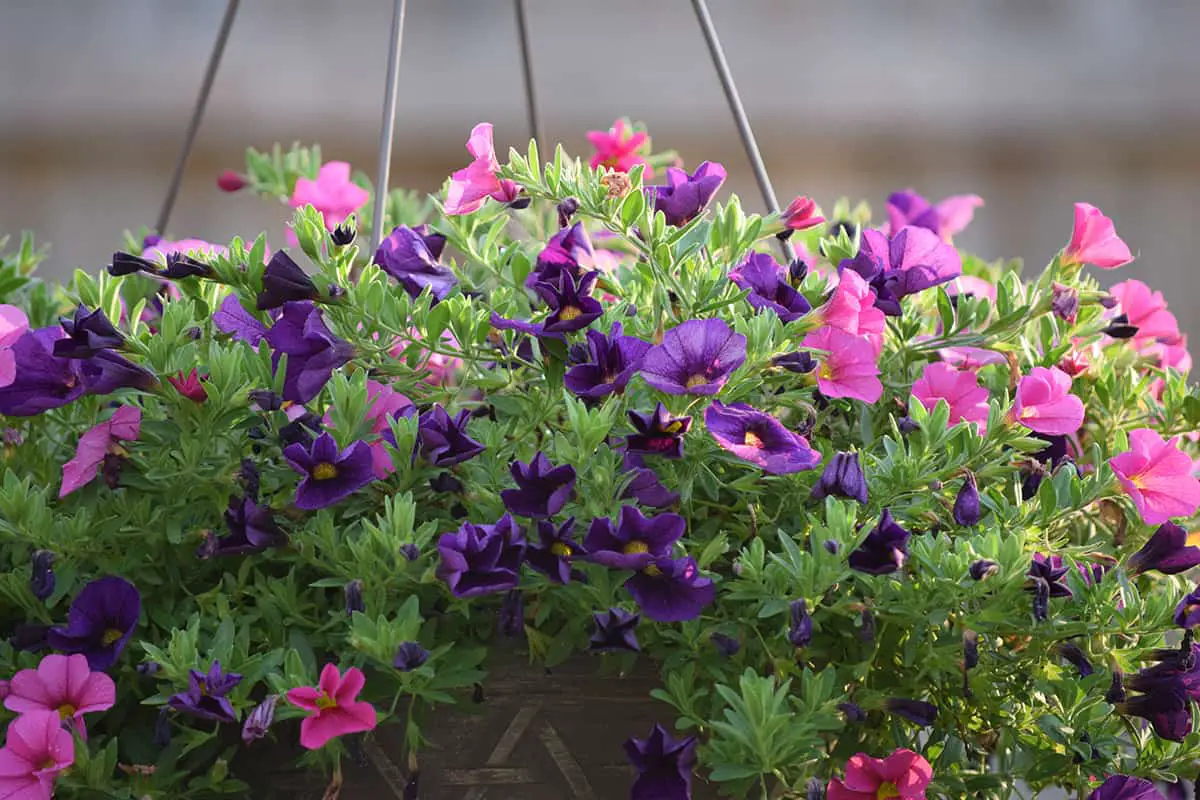
Impatiens are an excellent choice for your hanging baskets. They offer vibrant colors and work well in shaded spots. These plants have glossy leaves and flowers that range from 1 to 2 inches across. They may be single or double and come in many colors.
When planting impatiens, ensure the soil is moist and well-drained. You’ll find they’re perfect for adding a splash of color to your porch or patio. In larger baskets, you can fit more plants for a fuller look.
Space your impatiens 8 to 12 inches apart to allow them room to grow. They typically reach a height of 12 to 18 inches. With proper care, you can enjoy their blooms from spring until the first frost.
Care for your impatiens involves keeping the soil consistently moist. Also, place them in a partial to full shade location. This helps maintain their vibrant colors and prevents them from wilting.
Ivy (Hedera)
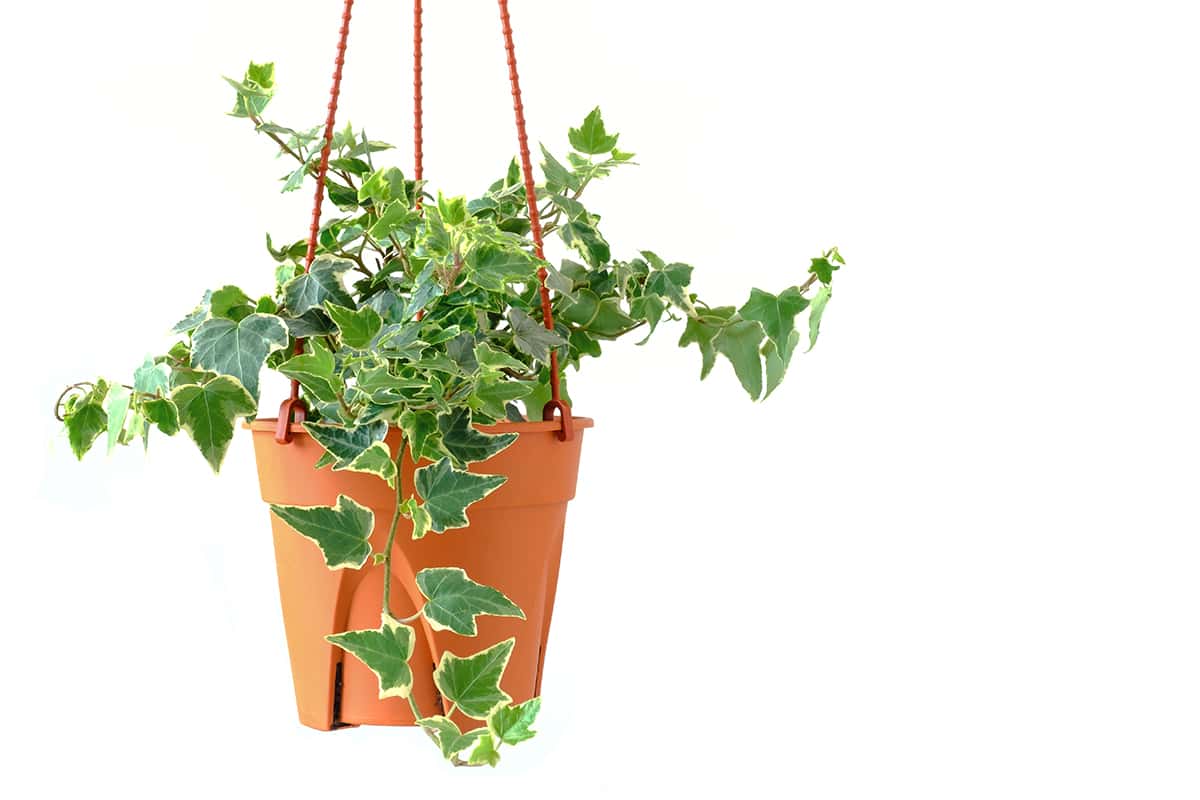
Ivy plants are ideal for hanging baskets with their trailing vines. Hedera helix, commonly known as English Ivy, is known for its ability to adapt to indoor environments. Your ivy needs bright, indirect light to thrive. Too much direct sunlight can scorch the leaves.
Water your ivy when the topsoil feels dry. Overwatering can lead to root rot, so ensure proper drainage. English Ivy prefers humid conditions. Consider misting the leaves or placing a humidifier nearby.
Pruning is essential to keep ivy manageable. Trim back the vines to maintain the shape of your basket. This practice also promotes thicker foliage growth.
Growing English Ivy indoors can purify your air. Studies suggest it filters out common toxins.
Verbena

When you select verbena for your hanging baskets, you’re choosing a plant known for its vibrant colors and hardiness. Verbena thrives in sunny spaces, requiring at least six hours of direct sunlight daily. These plants perform well in various settings, including pots and garden beds. However, for hanging baskets, certain varieties like compact-growing verbena are ideal due to their suitability for container gardening.
Your hanging baskets can flourish with verbena, as these plants adapt well to warm conditions and can tolerate dry spells to an extent. You’ll find verbena to be a versatile choice, fitting nicely into the ‘thriller, filler, and spiller’ design strategy often recommended for dynamic container displays. Their cascading growth habit makes verbenas a spectacular addition, enlivening your baskets with a range of color options.
For maintaining a healthy verbena display, ensure your baskets hold well-draining soil. Your verbenas will benefit from regular watering and occasional feeding, but be cautious to avoid waterlogged conditions that can lead to root rot. Deadheading spent flowers can also promote further blooming, keeping your baskets looking fresh throughout the growing season.
Spider Plant (Chlorophytum Comosum)
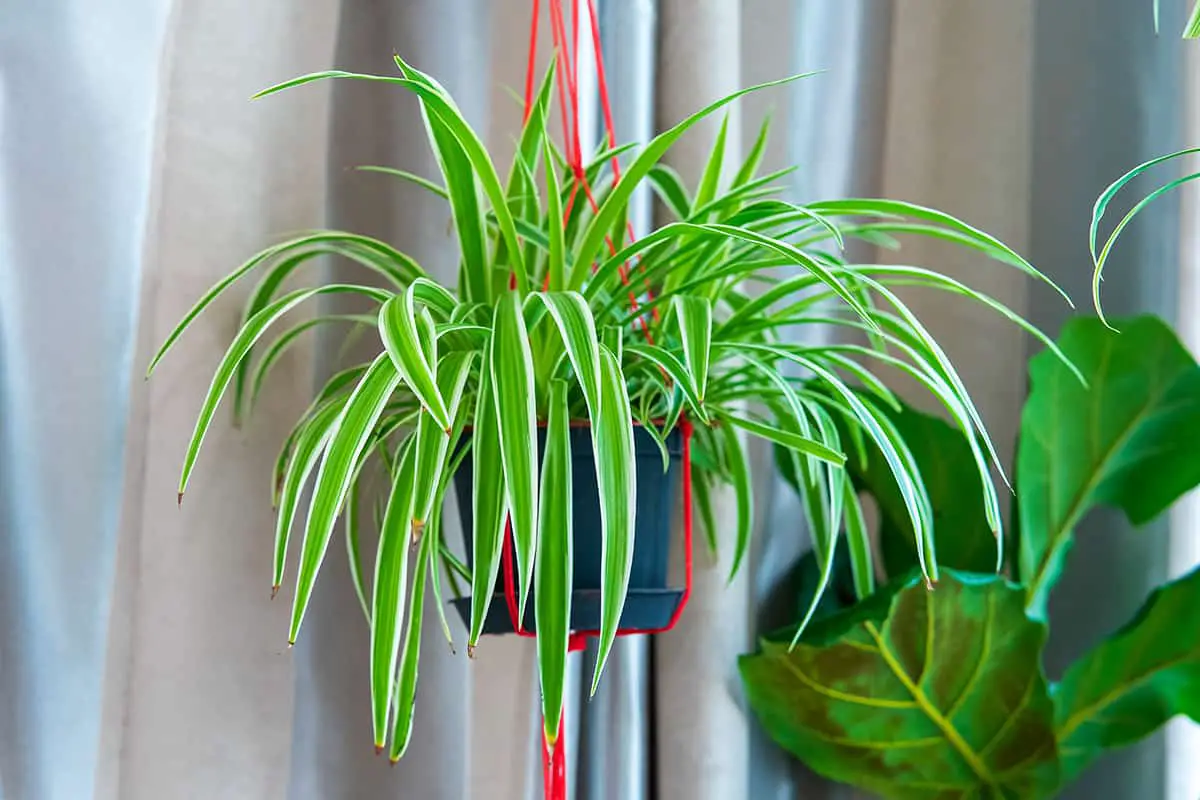
The Spider Plant, scientific name Chlorophytum comosum, is ideal for your hanging baskets. This plant thrives in bright, indirect light. You’ll find it’s not only resilient but also excels in purifying indoor air.
Your Spider Plant will display narrow, arching leaves. Many varieties offer leaves with white or yellow stripes. For a striking look, consider the ‘Vittatum’ variety which showcases a bold white stripe down the leaf center.
Expect this plant to grow quickly and easily. It produces runners with small plantlets at the ends that hang below the basket, adding to its appeal. Keep the soil moist but not waterlogged to promote healthy growth.
Spider Plants are also safe for pets. This makes them a worry-free choice for households with curious animals. Enjoy your Spider Plant’s lush foliage and ease of care.
Pothos (Epipremnum Aureum)
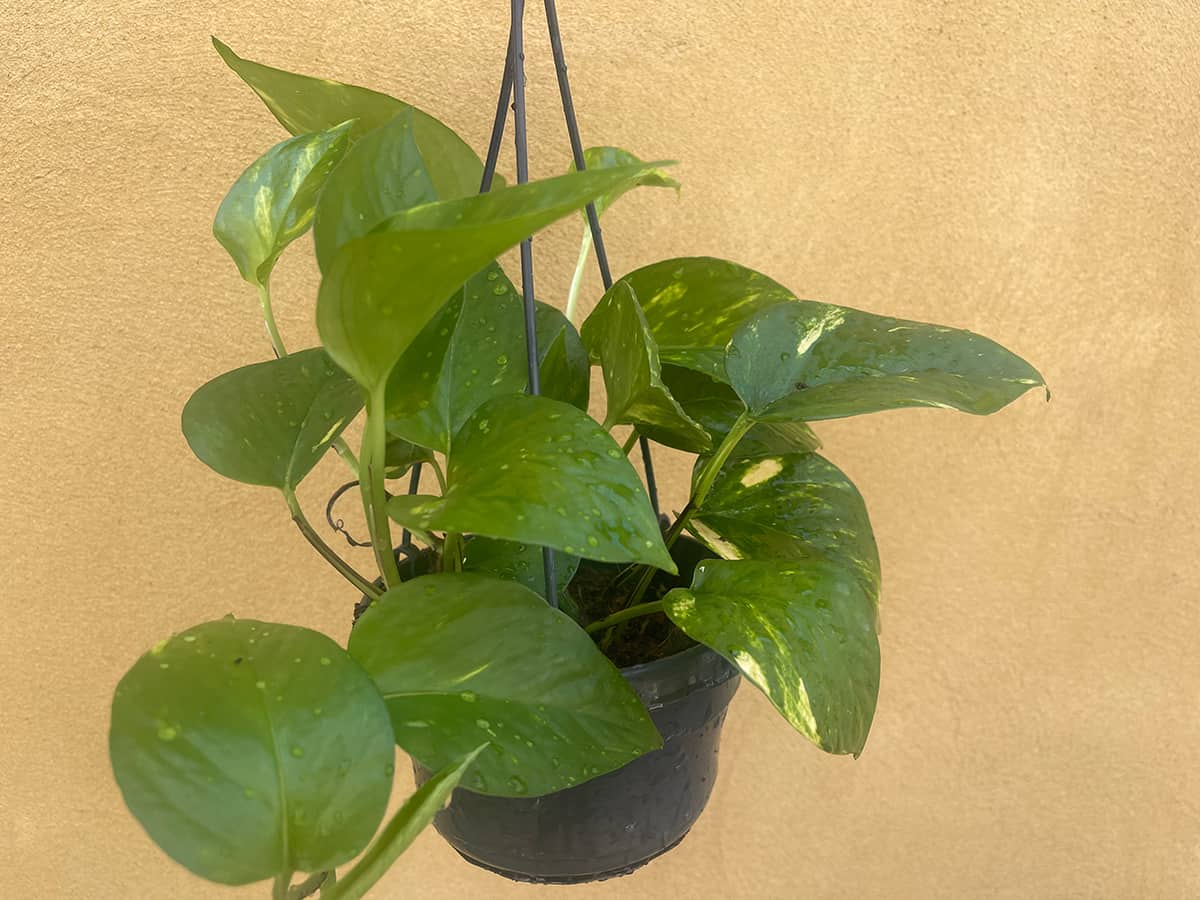
This plant has heart-shaped leaves that cascade elegantly, enhancing any space’s aesthetic. It thrives in indirect light, making it suitable for indoor environments.
You can expect a Pothos to be low maintenance. Its watering needs are minimal, preferring to dry out between sessions. You’ll find humidity to its liking, yet it’s resilient in less-than-ideal conditions.
As a versatile green, Pothos grows well on wood or foam poles or simply left to dangle. It adapts to various container sizes, a testament to its forgiving nature. For those starting with houseplants, Pothos stands out as an excellent choice.
This plant can grow quite long, presenting an opportunity for you to shape it as desired. With its ease of care and vibrant green foliage.
Bacopa (Sutera Cordata)

Bacopa, also known as Sutera Cordata, thrives in hanging baskets. As a low-growing, spreading plant, it flaunts very small leaves. Throughout the blooming season, this plant becomes laden with tiny, delicate flowers that can be lavender, pink, red, or white.
When you choose Bacopa for your garden, ensure it has full sun exposure. This plant reaches a mature height of 3 to 6 inches. It requires moist, well-drained soil to prosper. The trailing stems of Bacopa make it perfect for containers or as an accent in hanging baskets.
This plant often serves as a perennial groundcover, though many grow it as an annual. If you live in an area with occasional dry spells, Bacopa can tolerate it to some extent. For robust growth, you should water it generously, especially in the heat.
Trailing Snapdragon (Asarina)

Trailing Snapdragon, commonly known as Asarina, is a graceful plant. You can enjoy its delicate vines in hanging baskets. These plants bear striking flowers resembling small snapdragons.
Your Asarina thrives in hardiness zones 9 and 10. It prefers a variety of soils, with a partiality for loamy mixtures. Ensure the soil is well-draining. Climbing Snapdragon – Asarina antirrhiniflora finds its origins in the southwest US, where it grows in rocky terrain.
You will find that Asarina requires moderate maintenance. It needs a regular watering schedule. This plant enjoys full sun to partial shade. Check its moisture levels often to prevent overwatering or drying out.
In hanging baskets, Asarina cascades beautifully. This visual appeal makes it a popular choice. Its blooms offer a lovely aesthetic from spring to fall. Keep them in a spot that receives six hours of sunlight. This ensures optimal growth and flowering.
